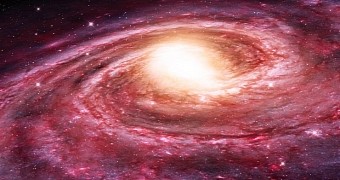Having used telescopes to peer into the makeup of fairly small galaxies circling the Milky Way, astronomers found that they are pretty much all out of star-forming gas.
Apparently, a cosmic bully is to blame for the fact that these galaxies are now devoid of hydrogen gas. Interestingly enough, it appears that this cosmic bully is none other than our home galaxy, the Milky Way.
The ins and outs of our cosmic neighborhood
In a paper in the Astrophysical Journal Letters, scientists with the National Radio Astronomy Observatory explain that the Milky Way is part and parcel of a group of galaxies that, due to gravitational forces, have no choice but to stick together.
Evidence at hand indicates that the Milky Way is the largest member of this group, and that it is surrounded by an impressive number of smaller galaxies. The Milky Way's groupies include dwarf spheroidals, which are low-luminosity galaxies shaped like a sphere.
Further out in space, there are irregular galaxies that, although not gravitationally bound to the Milky Way, seem to very much enjoy hanging out in its proximity, the National Radio Astronomy Observatory specialists further detail.
How the Milky Way is nothing short of a cosmic bully
As it turns out, the dwarf spheroidal galaxies that are the Milky Way's galactic neighbors are now all out of star-forming hydrogen gas. By comparison, dwarf galaxies that sit at a considerable distance from the Milky Way are pretty much spilling over with hydrogen gas.
“Astronomers wondered if, after billions of years of interaction, the nearby dwarf spheroidal galaxies have all the same star-forming ‘stuff’ that we find in more distant dwarf galaxies,” astronomer Kristine Spekkens explained in a statement.
“What we found is that there is a clear break, a point near our home Galaxy where dwarf galaxies are completely devoid of any traces of neutral atomic hydrogen,” the National Radio Astronomy researcher went on to add.
Kristine Spekkens and colleagues suspect that the Milky Way affects the makeup of its dwarf spheroidal neighbors due to the fact that it itself is located within a halo of hot hydrogen plasma, i.e. a collection of separate protons and electrons, that, at least up to a certain point, is dense enough to affect nearby galaxies.
“Within this ‘danger zone,’ the pressure created by the million-mile-per-hour orbital velocities of the dwarf spheroidals can actually strip away any detectable traces of neutral hydrogen,” the researchers offered as an explanation for this phenomenon.
The National Radio Astronomy Observatory scientists explain that, by forcing hydrogen gas out of its dwarf spheroidal neighbors, the Milky Way essentially shuts down star-formation processes in the galaxies unfortunate enough to sit close to it.

 14 DAY TRIAL //
14 DAY TRIAL //